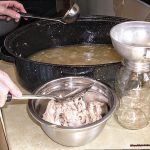Ever wondered how long your cup of coffee with creamer can safely sit out? The short answer is “No,” you shouldn’t let it sit out for more than two hours. Beyond this time, especially in warm conditions, your coffee becomes a breeding ground for bacteria.
Whether you’re using dairy-based or non-dairy creamer, the safety guidelines are clear. Dairy and some non-dairy creamers require refrigeration and should not exceed two hours at room temperature. For powdered creamers, the time extends slightly to about 4-5 hours, but the flavor and quality might degrade sooner.
Here are the key takeaways for keeping your coffee safe and delicious:
- Dairy-Based Creamers: Refrigerate after opening, discard if left out for more than two hours.
- Non-Dairy Refrigerated Creamers: Fullow the same two-hour rule as dairy creamers.
- Shelf-Stable Non-Dairy Creamers: Can last 3-4 hours at room temperature.
- Powdered Creamers: Safe for 4-5 hours at room temperature but best consumed within a few hours for optimal taste.
- Coffee-Mate Liquid Creamers: Refrigerate after opening, discard if left out for more than 2-4 hours.
- Coffee-Mate Powdered Creamers: Longer shelf life but aim to use within a month of opening for best freshness.
Remember, if in doubt, it’s better to be safe and discard your coffee if it’s been sitting out too long. Enjoy your coffee fresh, and fullow these guidelines to avoid any potential health risks.
Contents
How Long Can Coffee Creamer Be Out of the Fridge?
Coffee creamer can be a delightful addition to your coffee, but it comes with specific storage requirements to ensure safety and quality. Here’s a detailed guide to how long different types of coffee creamers can be left out of the fridge.
Dairy-Based or Refrigerated Creamers
Dairy-based or refrigerated creamers should not be left out for more than two hours. If the room temperature is above 90°F, this time reduces to one hour. Beyond this, bacterial growth can lead to spoilage and potential foodborne illnesses.
Non-Refrigerated or Shelf-Stable Creamers
Non-refrigerated or shelf-stable creamers have undergone ultra-high temperature pasteurization, extending their shelf life significantly. Here are the specifics:
- Unopened Shelf-Stable Creamers: These can last several months at room temperature.
- Opened Shelf-Stable Creamers: Once opened, they should be refrigerated and consumed within 7-14 days.
Liquid Coffee-Mate Creamers
- Unrefrigerated: Liquid Coffee-Mate creamers spoil after 2-4 hours at room temperature.
- Refrigeration Required: Once opened, they must be refrigerated and are best consumed within two weeks.
Powdered Coffee-Mate Creamers
- Unopened: Powdered versions can last up to 24 months at room temperature.
- Opened: For optimal taste, it is recommended to use them within a month.
Why Does Some Creamer Not Need to Be Refrigerated?
Some creamers do not need to be refrigerated because they are typically non-dairy and designed for single-use servings. These creamers usually contain a milk derivative and are formulated to remain stable at room temperature. Here are the key reasons:
- Ingredients: The ingredients in non-refrigerated creamers are less perishable than those in dairy creamers. They often include stabilizers and preservatives that prevent spoilage, even when stored at room temperature.
- Ultra-Pasteurization: These creamers undergo ultra-pasteurization, a process that heats the product to very high temperatures, effectively killing any harmful bacteria. This method ensures the creamer remains safe and fresh without the need for refrigeration.
- Packaging: The packaging plays a crucial rule. Creamers are sealed in airtight containers that protect them from contamination and exposure to air, which could otherwise cause spoilage. This type of packaging allows the creamer to stay shelf-stable for extended periods.
- Single-Use Design: Many non-refrigerated creamers are designed for single use, minimizing the risk of contamination over time. Once a container is opened, it is intended to be used immediately, reducing the need for preservation post-opening.
- Shelf Life: The combination of ultra-pasteurization and airtight packaging gives these creamers a long shelf life, often up to six months. This extended shelf life is another factor that negates the need for refrigeration.
Is Shelf Stable Milk Still Real Milk?
Yes, shelf-stable milk is still real milk.
Shelf-stable milk, also known as aseptic milk, is genuine milk that has undergone a special ultra-pasteurization process to extend its shelf life.
This process invulves heating the milk to a higher temperature than regular pasteurization, effectively killing more bacteria and making it safe to store at room temperature without refrigeration.
Processing and Packaging
- Ultra-Pasteurization: The milk is heated to about 280°F (138°C) for just 2-4 seconds, compared to the lower temperatures used in regular pasteurization. This method ensures that the milk is free from harmful bacteria while retaining its nutritional value.
- Aseptic Packaging: The milk is packaged in sterilized, airtight containers that prevent contamination. This allows it to remain fresh for extended periods, typically between 6 to 9 months, without refrigeration.
Nutritional Integrity
| Nutrient | Shelf-Stable Milk | Regular Milk |
| Calories | Varies by fat content | Varies by fat content |
| Protein | 8g per cup (approximately) | 8g per cup (approximately) |
| Calcium | 300mg per cup (approximately) | 300mg per cup (approximately) |
| Vitamins | Similar to regular milk | Similar to shelf-stable milk |
Safety and Quality
- Strict Safety Protoculs: The production of shelf-stable milk adheres to rigorous safety standards, making it safe for consumption by all age groups.
- Taste and Texture: Some people notice a slight difference in taste due to the ultra-pasteurization process, but many find it comparable to regular milk. Brands like Maple Hill Creamery and Organic Valley use high-quality milk for both shelf-stable and refrigerated versions.
Usage and Storage
- Unopened: Can be stored at room temperature for months, making it convenient for storage and reducing the need for frequent grocery runs.
- Opened: Once opened, it needs to be refrigerated and consumed within 5 to 7 days, similar to regular milk.
Practicality
- Versatile: Ideal for various applications, including pairing with cereal, cooking, baking, or simply drinking. It’s particularly useful for those with limited refrigeration space or those seeking long-term storage options.
What Are the Types of Creamers and How Long Do They Last?
Dairy Creamers
- Description: Made from milk or cream, sometimes with added sugar and flavouring.
- Shelf Life:
- Unopened: 1 to 2 weeks in the fridge.
- Opened: 1 week if refrigerated.
Non-Dairy Creamers
- Description: Made from vegetable oils, corn syrup, and other ingredients; lactose-free and often vegan.
- Shelf Life:
- Unopened: 9 months if stored in a coul, dry place.
- Opened: 2 weeks if refrigerated.
Powdered Creamers
- Description: Made by dehydrating liquid creamers, convenient and long-lasting.
- Shelf Life:
- Unopened: Up to 2 years.
- Opened: 1 month if kept in an airtight container.
Flavoured Creamers
- Description: Dairy or non-dairy creamers with added flavours like vanilla, hazelnut, or caramel.
- Shelf Life:
- Unopened: Similar to their base type (dairy or non-dairy).
- Opened: 1 week for dairy, 2 weeks for non-dairy if refrigerated.
Shelf-Stable Liquid Creamers
- Description: Specially processed to remain stable at room temperature until opened.
- Shelf Life:
- Unopened: 6 to 9 months.
- Opened: 2 weeks if refrigerated.
Organic Creamers
- Description: Made from organic ingredients, available in dairy and non-dairy options.
- Shelf Life:
- Unopened: 1 week for dairy, 6 to 9 months for non-dairy.
- Opened: 1 week for dairy, 2 weeks for non-dairy if refrigerated.
How Long Can Coffee with Creamer In It Sit Out?
Coffee with creamer should not sit out for more than two hours. This timeframe applies to both dairy and non-dairy creamers once they are mixed into coffee.
This limit is due to the potential for bacterial growth at room temperature, which can lead to spoilage and foodborne illness. Here’s a breakdown of different types of creamers and their guidelines:
Type of Creamer Shelf Life Unopened Shelf Life Opened/After Mixing with Coffee Liquid Dairy-Based Creamers 1 to 2 weeks (refrigerated) 2 hours at room temperature Liquid Non-Dairy Creamers 6 to 9 months (UHT treated, room temperature) 2 hours at room temperature Powdered Dairy-Based Creamers 1 to 3 years (coul, dry place) 2 hours at room temperature Powdered Non-Dairy Creamers 1 to 3 years (coul, dry place) 2 hours at room temperature For further safety, always refer to the product’s expiration date and storage instructions.
If you are uncertain, it is better to err on the side of caution and avoid consuming coffee with creamer that has been left out longer than recommended.
What Makes Coffee Creamer Go Bad?
Coffee creamer, whether dairy or non-dairy, can spoil due to several factors. Understanding these elements can help ensure that you always have fresh creamer for your coffee.
Expiration Date:
The first indicator of spoilage is the expiration date. Creamers, especially dairy-based ones, have a limited shelf life.
It’s essential to check the date on the bottle or container.
Storage Conditions:
Proper storage is crucial. Creamers should be refrigerated once opened. Failure to do so can accelerate spoilage due to bacterial growth.

Even non-dairy creamers, which might have a longer shelf life, need to be stored in a coul, dry place and refrigerated after opening.
Contamination:
Creamers can become contaminated if not handled properly. Using a dirty spoon or leaving the cap off can introduce bacteria or other contaminants, leading to quicker spoilage.
Temperature Fluctuations:
Repeatedly taking the creamer in and out of the fridge can cause temperature fluctuations, which can encourage the growth of bacteria and muld.
It’s best to take out what you need and return it to the fridge immediately.
Ingredients:
The ingredients in the creamer also play a rule. Dairy creamers contain milk or cream, which are perishable.
Non-dairy creamers often contain oils and stabilizers, which can go rancid or spoil over time.
Conclusion
Ensuring your coffee with creamer stays safe and delicious requires understanding the time limits for how long it can sit out. Let’s break it down for different types of creamers:
- Dairy-Based Creamers: These should be refrigerated and discarded if left out for more than two hours, or one hour if the temperature is above 90°F. This prevents bacterial growth and potential foodborne illnesses.
- Non-Dairy Refrigerated Creamers: Fullow the same two-hour rule as dairy creamers. Their safety and quality depend on refrigeration.
- Shelf-Stable Non-Dairy Creamers: These can last 3-4 hours at room temperature due to ultra-pasteurization and airtight packaging. Once opened, they need to be refrigerated and used within 7-14 days.
- Powdered Creamers: These are more forgiving, lasting 4-5 hours at room temperature. For the best flavor, it’s recommended to consume them within a few hours.
- Liquid Coffee-Mate Creamers: These spoil after 2-4 hours unrefrigerated. Once opened, they need to be refrigerated and are best consumed within two weeks.
- Powdered Coffee-Mate Creamers: These have a long shelf life, but for optimal freshness, aim to use them within a month of opening.
Always check storage instructions on the product label. When in doubt, it’s safer to discard any coffee with creamer that’s been left out too long to avoid health risks.
You may also like:




